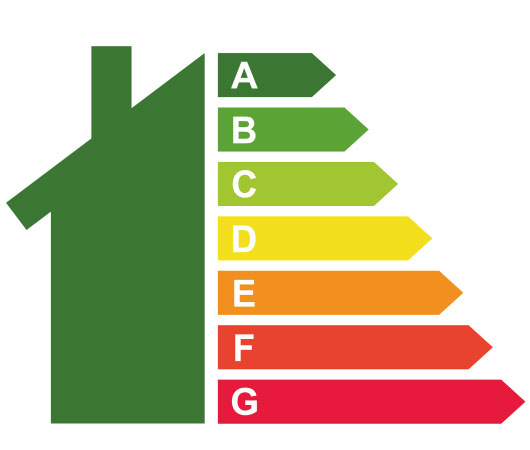THERMALLY DRIVEN
HEAT PUMPS
Thermally driven heat pumps (TDHP)1 use fuels such as natural gas or green gases as the source of energy to transfer heat from the environment to the interior of buildings. Because they make the most of already existing heat, these heat pumps are very efficient.
There are three main technologies of thermally driven heat pumps, depending on how environment heat is transferred from the outside to the inside of the building:
1) gas sorption heat pumps (GAHP) that are based on two different principles, absorption or ad-sorption
2) thermal compression heat pumps (TCHP)
3) gas engine heat pumps (GEHP)
Let’s see the ab-sorption Heat pumps that are particularly well suited for existing buildings. This is because they can very efficiently heat up water to high temperatures. This characteristic makes them suitable for renovation projects where the original old types of radiators – called high-temperature radiators – have to be kept.
The best of both worlds
and up to 40 % energy saving on top

If you have an older house, it can be difficult to install renewable energy systems for your heating and hot water. Challenges related to insulation, expense, or existing heating appliances can limit the effectiveness of appliances like electric heat pumps. And you may end up with a heating system that’s not as efficient as you expect.

The good news is there’s new technology that gives you the benefits of renewable energy, along with the heating and hot water performance you’re used to from a gas-fired boiler and radiators.
GAHPs (Gas Absorption Heat Pumps) use renewable energy with heat pump technology in a thermodynamic process – transferring energy from one place to another – driven by an ultra-efficient gas burner.

This solution for heating and hot water is perfect for installing in older homes. It uses renewable sources, is sustainable and incredibly effective. Plus, it will reduce your energy bills, lower harmful emissions to the environment and save you money in the long run.
So, why not enjoy
the best of both worlds?
Explore these pages to find out, how it saves energy
and where you can find more information or the answers to your questions.
Three reasons
to choose GAHP

ECOLOGY
The climate is changing and we can all play our part in reducing emissions and our carbon footprint. Find out how GAHPs harness renewable technology to make a difference.

ECONOMY
Renovating an older house to make it work with an electrical heat pump can be daunting and a big undertaking. Find out how GAHPs can significantly decrease your energy consumption and CO2 emissions, without having any extra work on your existing home.

EFFICIENCY
Energy bills are rising, so getting the most out of your heating system is vital. By combining the latest gas burner technology with renewable heat pumps, GAHPs are incredibly energy efficient. Find out how.

ECOLOGY

The last four years were the hottest on record, according to the World Meteorological Organisation2. And billions of tons of CO2 continue to be released into the atmosphere every year as a result of oil, coal and gas production. The United Nations describes this as a “climate crisis”3.
But we can each do our bit to change the trajectory.
Much like Governments and industry across the world, we can all take responsibility for reducing our own emissions, reduce what we consume and find new ways of limiting our harm on the environment.


Older homes tend not to be energy efficient and often have single glazed windows and bad insulation, which can cause heat to escape easily – meaning they can use a lot more non-renewable energy and increase harmful environmental emissions. However, improvements can be made by insulating attic spaces and replacing or draught proofing windows and doors.

Plus, choosing the right heating and hot water system can make a huge difference.
Using the technology of gas absorption heat pumps, which combine renewable energy with ultra-efficient gas burners, is a great way of moving towards zero harmful emissions from your home.

So, now you can reduce your impact on climate change, and enjoy a warm home with plenty of hot water.
Read more about how GAHPs contribute to save the Environment

ECONOMY

There are two main issues that people with older properties have to wrestle with when it comes to heating and hot water.

The first
is the ongoing cost of gas or electricity to generate heat – and those bills seem to be getting ever more expensive.

And secondly,
adding renewables to an older house can be prohibitively expensive. It’s not just the cost of the heat pump, for example – there are other considerations. Electric heat pumps are very efficient at lower flow temperatures, so you usually need to swap all your radiators for larger ones, or install alternatives such as underfloor heating. These big changes are often complex in an older home and can be expensive.
According to a study by the EU, large or “deep” renovations to existing homes only happen sporadically4, which is when homeowners typically consider how their homes are heated. Therefore, it’s very difficult to reduce the required energy use to stem harmful greenhouse gas emissions from older homes.
So, if you’re not able to completely renovate your home, is it still possible to quickly decrease your energy consumption and reduce your carbon footprint? The answer is yes, thanks to GAHP systems.

Thanks to their innovative technology, GAHPs can reduce energy bills, as well as eliminate the need to replace existing radiators and hot water tanks. It really is a win-win when it comes to economy. After all, a GAHP uses 30% renewable energy, so it will save money (along with helping the environment), and is the ideal heating system for older homes, because installation is easier and more cost-effective.
So, if you’re looking to reduce your energy bills without the big expense of completely changing your heating system and improving your insulation level, then a GAHP may be the ideal option for you.
Read more about how GAHPs simplificate renovations.

EFFICIENCY

Older homes are less energy efficient. According to the EU, today’s new buildings consume half the energy they did in the 1980s5.
Across Europe, buildings consume 40% of overall energy and emit 36% of total CO2 emissions.
Homes that use energy supplied from fossil fuels are responsible for significant amounts of carbon dioxide (CO2). Therefore, it’s vital to improve the efficiency of appliances that use energy from fossil fuels to reduce the emissions responsible for climate change6.

Energy efficiency means using less power to light or heat your home or run your appliances.

For example: changing appliances such as fridges and televisions for more efficient versions, and switching to LED bulbs, which require less electricity than traditional incandescent bulbs.

Of course, there are also additional measures to reduce the amount of energy that needs to be used to heat your home. Along with installing double glazing, as well as insulating walls and roof spaces, choosing a heating and hot water system that uses renewable energy will really help to create an energy efficient home.

Gas absorption heat pumps, which combine a renewable energy source with ultra-efficient gas burner technology, have efficiencies of 130% – which means for every unit of energy used, the system generates an extra 30% of heating energy for free!
Perfect for older homes, where adding a renewable system can be difficult, GAHPs use innovative technology that tried and tested – heating your home in the most energy efficient manner.
Read more about how GAHPs work in more detail
1 Thermally driven heat pump as defined in the draft Regulation (EU) 813/2013 and 814/2013: “Thermally driven heat pump means a heat pump using heat or an engine to drive the sorption or compression cycle”.
2 WMO confirms past 4 years were warmest record
3 Climate crisis race we can win
4 Comprehensive study of building energy renovation activities and the uptake of nearly zero-energy buildings in the EU, 2019
5/6 Focus energy efficiency buildings 2020








